Picture this: you’re at your first guitar jam session, hesitant yet eager to contribute. Everyone’s improvising, and you, clutching your guitar, are unsure of your first move. This is where the D major pentatonic scale becomes your key to unlocking a realm of musical possibilities. Before I discovered the power of this scale, moments like these filled me with dread. Yet, finding my voice within these five notes transformed not only my playing but also my confidence. Understanding guitar scales, particularly the seemingly straightforward yet versatile D major pentatonic, empowers guitarists to break free and explore creatively during those defining musical exchanges.
The gift of the D major pentatonic scale is its simplicity, offering guitarists a gateway to originality without overwhelming complexity. As Adam Perlmutter wisely observes, mastering scales is essential for any guitarist who values creativity and improvisation. With this guide, we’ll explore the depths of the D major pentatonic scale, equipping you with the knowledge, skills, and confidence to transform your playing.
What is the D Major Pentatonic Scale?
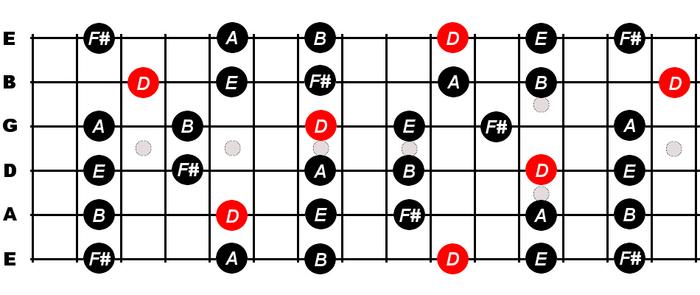
As someone deeply immersed in the world of music theory, I’ve always found joy in unearthing the inherent beauty of musical scales. One scale that stands out prominently is the D Major Pentatonic Scale, a melodic treasure that’s universally admired. Its allure lies in its simplicity and versatility, making it a staple in various musical genres, from rock to jazz.
Now, what makes the D major pentatonic scale a favorite among musicians across genres? It essentially distills the essence of the D major scale, focusing on the most stable and harmonious notes to craft a smoother melodic flow. By omitting the fourth and seventh notes of the standard D major scale, it reduces dissonance—those tripping hazards of the musical world—created by the leading and subdominant tones. The result is a scale formula that resonates with clarity and peace.
My own experiences playing guitar have shown that this pentatonic scale is a powerful tool for crafting memorable solos and improvisations. Its refined structure allows for creative expression without the fear of stumbling into jarring intervals. The ability to glide effortlessly over chord changes using this scale is one of the many reasons why it became a cornerstone of my musical toolkit.
This scale’s ability to cross stylistic boundaries so effortlessly underscores its wide-reaching appeal. As we delve deeper into its why, who, when, and how, you’ll discover for yourself the myriad ways the D major pentatonic scale can enhance your musical journey.
Why Use the D Major Pentatonic Scale?
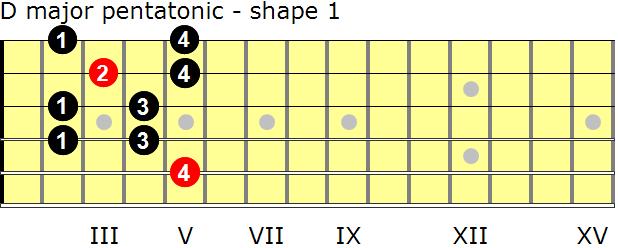
Is the D major pentatonic scale the secret weapon for improvisation that many guitarists overlook? To me, it absolutely is. In my journey as a guitarist, I’ve found that this scale offers an *exceptional* palette for crafting melodic lines that truly resonate with listeners. The D major pentatonic is a simplified five-note scale that removes some of the complexities found in the full major scale, making it a perfect tool for *smooth and expressive* improvisation.
One of the strengths of the D major pentatonic scale is its versatility. Whether you’re diving into the depths of blues or soaring through the peaks of rock solos, this scale forms the underpinning of *dynamic soloing techniques*. It’s a cousin to the blues scale, and its structure offers a perfect gateway between various musical styles, giving you the freedom to add your unique flair while maintaining a classic feel.
My discovery of the D major pentatonic scale transformed my approach to soloing. Instead of getting tangled in the complexities of more intricate scales, I began to focus on creating *emotionally powerful* and *accessible* solos. This streamlined framework allows you to explore and develop memorable themes, making it easier to connect with your audience.
Using the D major pentatonic scale, my solos evolved from being mere technical exercises into heartfelt expressions that captured the essence of each performance. It’s one thing to play the notes; it’s another to tell a story with them. With this scale, I’ve found a way to do just that.
Who Can Benefit from the D Major Pentatonic Scale?
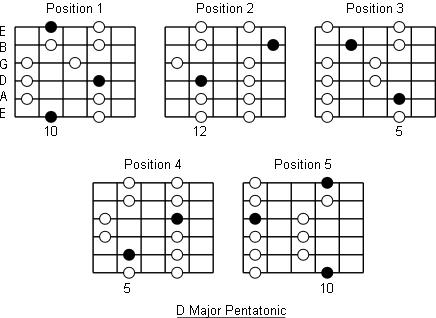
Could the D major pentatonic scale be the gateway for beginners and experienced players alike to unlock musical creativity? In my years of offering guitar lessons, I’ve witnessed this scale as an essential tool for learning and growth. It’s not just a pattern on the fretboard; it’s a vehicle for discovery. Whether you’re just starting out or honing your skills, the D major pentatonic scale provides a foundation that enhances both confidence and technique on the guitar.
For beginners, this scale is a straightforward entry point into the world of music theory guitar. It allows for the exploration of melodies without the intimidating flats and sharps. As students master these simple patterns, they quickly find joy and motivation to delve deeper into guitar playing. On the other hand, seasoned players find the pentatonic guitar scale to be a versatile tool for improvisation and songwriting. Its simplicity is its strength, enabling musicians to focus on expression and creativity without getting bogged down in complexity.
Through mastering this scale, I’ve seen students blossom, overcoming initial hurdles and seamlessly transitioning into more complex pieces. It’s not just about learning notes; it’s about building a connection with the instrument, sparking creative expression, and enjoying the journey of musical exploration. In essence, the D major pentatonic scale stands as a pillar of progress for guitarists at any level.
When to Use the D Major Pentatonic Scale?
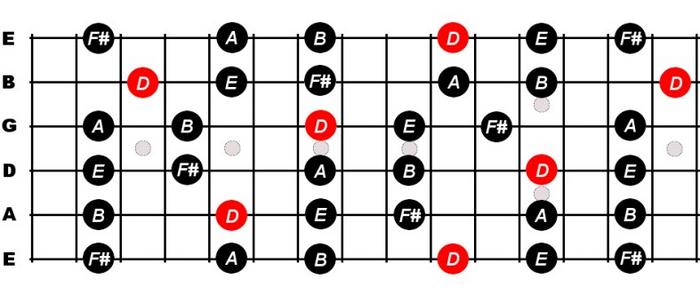
When is the ideal time to showcase the D major pentatonic scale in your music? This question has intrigued many guitarists, seeking to unlock the full potential of their instruments. With years of performing and analyzing songs, I’ve discovered that the answer lies within the synergy it creates with various chord progressions. The D major pentatonic scale is more than just a sequence of notes; it’s a dynamic tool that can transform melodies with an unparalleled vibrancy and *emotional depth*. Its simplicity allows guitarists to explore rich harmonies effortlessly, often within the framework of the CAGED system.
In my experience, some of the most impactful moments on stage have occurred when seamlessly integrating this scale in moments of musical tension or transition. For instance, blending it with major chords or incorporating it within a bridging section of a song can elevate its *technical prowess*. This scale truly shines in creating beautiful, lyrical solos that resonate with the audience. It provides a beautiful contrast and relief in complex compositions, filling the musical gaps with an uplifting tone. The D major pentatonic scale is not just versatile but also forgiving, making it a powerful device for guitarists across all skill levels to experiment and grow with it.
Take the time to familiarize yourself with its nuances; its ability to enhance musical expression is boundless. By understanding when and how to use this scale, you can turn standard performances into captivating experiences that linger with your listeners.
How to Play the D Major Pentatonic Scale
D Major Pentatonic Scale Notes
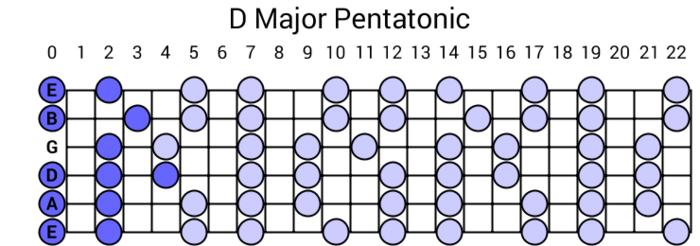
Did you know that the notes of the D major pentatonic scale fit beautifully into many musical styles? In my experience, understanding and mastering the notes D, E, F#, A, and B not only allows you to navigate the lovely landscapes of this scale but also arms you with a versatile musical toolset. The simplicity of these five notes provides a wide range of expressive possibilities on the guitar.
As a musician, I’ve discovered that knowing these specific notes can unlock captivating melodies that are both simple and expressive. This scale’s beauty lies in its ability to eliminate dissonance while enhancing the expressiveness of your playing. When performing a solo or constructing a melody, I rely on *these notes* to craft engaging musical pieces that resonate well with audiences across different genres.
Understanding how these notes come together is crucial before you can start playing the D major pentatonic scale effectively. Next, let’s explore further with diagrams that illustrate finger placement, ensuring you are well-equipped to incorporate this scale effortlessly into your playing.
D Major Pentatonic Scale Diagram

How can a visual representation of the D major pentatonic scale simplify the learning process? As an editor and engraver, I’ve found that incorporating a scale diagram markedly boosts a guitarist’s ability to comprehend and internalize scale shapes. When embarking on the journey of how to play the D major pentatonic scale, it’s vital to have a clear visual roadmap. For guitarists, a well-crafted guitar scale diagram is an indispensable tool. This chart distills complex musical concepts into an accessible format, thereby aiding in the cultivation of muscle memory and spatial awareness on the fretboard.
By highlighting each note’s position, the diagram functions as a visual cue that guides learners through the scale, promoting quick recognition and instant recall during practice. This structured representation not only supports beginners in grasping the basics but also enables seasoned players to explore advanced improvisation techniques. Ultimately, a precise scale diagram serves as a bridge between theory and practice, fostering a deeper understanding of the D major pentatonic scale and enhancing the learning experience for guitarists at every level.
Practicing the D Major Pentatonic Scale
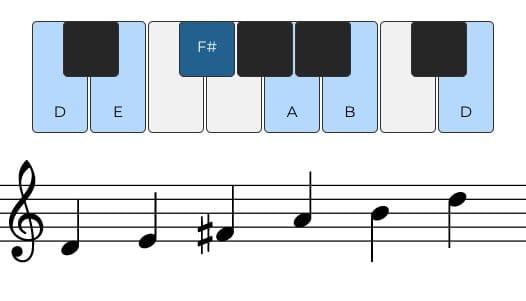
What practice methods can maximize your fluency with the D major pentatonic scale? As a guitar teacher, I believe the key lies in combining structured routines with creative freedoms. When it comes to honing the D major pentatonic scale, I introduce my students to *innovative approaches* that facilitate both *mastery and improvisation*. This scale is not only a foundational element covered in guitar lessons but also a tool for unlocking creative expression across genres.
For effective practice, start by dedicating time daily to play the scale in different positions on the guitar neck. Use a metronome to ensure *rhythmic precision* and gradually increase speed. This builds muscle memory and boosts confidence in shifting between positions. Additionally, try utilizing the scale in musical contexts—it could be as simple as jamming over a backing track or as complex as crafting your own riffs. Experimentation fosters a deeper connection with the pentatonic guitar scale, helping you transcend technical limitations.
To make practice sessions engaging, incorporate ear training by identifying the scale during your favorite songs. This not only reinforces your understanding but also highlights the scale’s versatility in applications like blues and rock music. Ultimately, patience and *dedicated practice* transform proficiency into artistry, empowering you to express yourself through improvisation. This methodical approach not only enhances your skills but also prepares you to explore and implement the D major pentatonic scale creatively in various musical contexts—echoing themes explored later in the complete guide.
Applications of the D Major Pentatonic Scale
In Blues Music
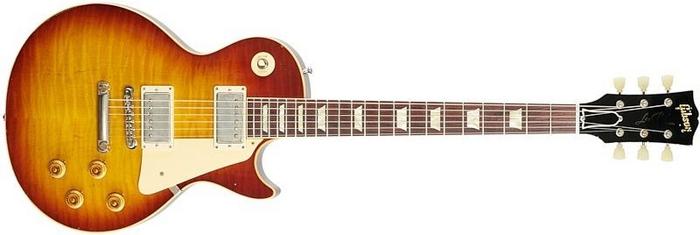
As a guitarist deeply rooted in the world of blues, I’ve personally witnessed how the emotional expression embedded within the D major pentatonic scale lets musicians forge unparalleled connections with their audiences. What makes the pentatonic scale so essential in the world of blues music? It’s the scale’s ability to encapsulate the raw and emotive essence so intrinsic to this genre. Its simplicity allows for immediate engagement, ideal for crafting intricate *blues solos* with both precision and depth.
In my years of playing, I’ve found the undeniable influence of the blues scale intricately woven into this pentatonic framework, perfectly tailored for the genre’s hallmark *soloing techniques*. When you explore the pentatonic shapes up and down the fretboard, you’re tapping into more than mere notes; you’re channeling decades of rich musical heritage. Each bend and slide evokes a visceral response, turning simple melodies into soulful narratives.
This balance of *technical ease* and profound emotional reach transforms live performances, resonating with listeners in a profoundly enduring way. As we further delve into the distinct genres, keep in mind how these simple patterns form the foundation of so many styles yet fuel such varied and powerful expressions.
In Rock Music

Can the D major pentatonic scale be a game-changer in rock music improvisation? From my experience, the answer is a resounding yes. It’s an essential tool in the rock guitarist’s arsenal. When you’re in the throes of a live performance or a jam session, employing the D major pentatonic scale adds a distinctive flair to your solos. It seamlessly fits into common rock chord progressions, enhancing the dynamics and emotional depth of your music.
Drawing from iconic rock performances over the years, I’ve seen how this scale becomes the go-to for guitarists striving for that signature rock sound. Its simplicity allows for fast and intuitive improvisation while providing enough flexibility to express complex emotional textures. Whether you’re evoking the high-energy anthems of the 70s or modern rock ballads, this scale serves as a versatile backdrop, blending ease of use with rich tonal possibilities.
By mastering it, you unlock a world of creativity, allowing your guitar to sing in a language that resonates deeply with your audience.
FAQs
What is the D Major Pentatonic Scale?
Why is the D Major Pentatonic Scale important for guitarists?
How do I play the D Major Pentatonic Scale on the guitar?
What are some songs that use the D Major Pentatonic Scale?
Can beginners learn the D Major Pentatonic Scale easily?
Conclusion
What lasting impact does mastering the D major pentatonic scale have on your guitar journey? As I reflect on my own experiences, I can confidently say that *understanding scales* like the D major pentatonic has been transformative. By grasping its structure, we’ve not only enhanced our *playing skills* but also unlocked a world of *improvisational possibilities*. This scale provides a foundation that guitarists of all levels can benefit from, allowing *expressive and creative freedom* across genres such as blues and rock. Embrace this scale and let it propel your musical journey to new heights, offering endless ways to innovate and explore.

